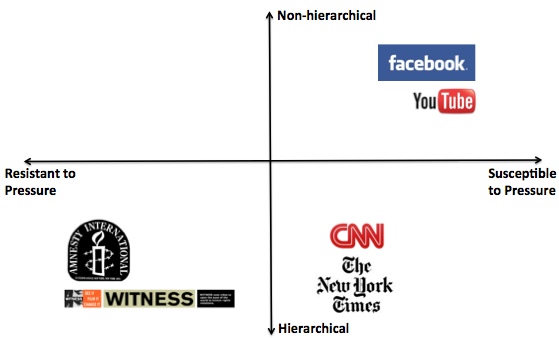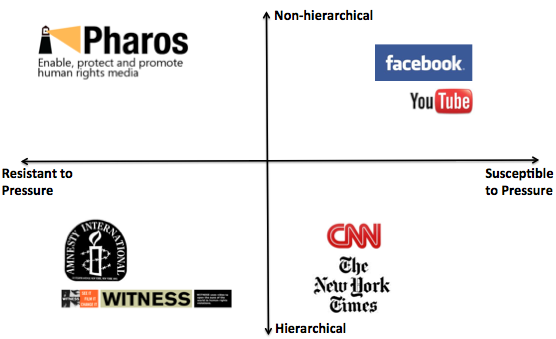Existing Services
Human rights videos are currently disseminated through a variety of traditional and new media outlets. While these services have allowed many important human rights videos to reach an unprecedented audience, they are currently inadequate in two ways. First, none of the existing solutions have the proper alignment of incentives to effectively and fully support human rights media. Second, no existing service provides both secure anonymous uploading mechanisms and tools to ensure the anonymity of the videos’ subjects.
Alignment of Incentives
To explain why none of the current solutions have adequately solved the problems facing human rights media, it is helpful to plot these solutions along two important axes. First, the horizontal axis measures how susceptible organizations are to government and financial pressures. Organizations that are more susceptible to pressure can be found on the right-hand side of the chart, while organizations that are resistant to these pressures reside on the left-hand side. Second, the vertical axis looks at the extent to which an organization filters the content it publishes. At the top, non-hierarchical organizations generally take a hands-off approach to the content available on their websites, accepting most forms of user-generated content. Hierarchical organizations, on the other hand, exercise great control in the selection and promotion of the content that they publish. The basic chart is presented below.
Mapping the Competition
Second Quadrant
The Second Quadrant, in the upper right of the chart, includes for-profit, multinational organizations that host user-generated content. YouTube and Facebook are two popular organizations that fall directly into this quadrant.[1] Anyone with access can upload content to YouTube and publish it to the world, as long as it does not violate YouTube’s Community Guidelines (e.g. the video contains pornography or graphic violence).[2] Although YouTube is well-suited to host and disseminate large amounts of human rights media, it is still subject to outside pressures. Governments can force YouTube to limit the availability of certain content by threatening to block the site in their country. In 2008, for example, YouTube removed a controversial video critical of Islam in order to end Pakistan’s ban of the site.[3] Such actions illustrate precisely why Second Quadrant organizations are insufficient to serve as publishers of human rights media: although they host most forms of user-generated content, their profit-seeking status leaves them susceptible to pressure to censor that content.
Third Quadrant
Actors in the Third Quadrant also do not provide an ideal platform for promoting human rights media. This space is dominated by traditional news organizations such as The New York Times, CNN, Reuters, and the Associated Press, as well as newer user-generated services like CNN iReport. Although these organizations are subject to many of the same financial pressures as Second Quadrant organizations, they are generally less willing to cater to oppressive governments. The real problem with using these organizations to promote human rights media, however, is the hierarchical structure they use to select content. Many organizations lack a system by which users can send in their content for publication, forcing them use services like YouTube. Even if an organization does accept user-generated content, editors ultimately decide which information is worthy of the limited time or space they have to present the news. When these large news organizations cover human rights abuses, they often focus on countries where Western powers have some involvement.[4] Thus, Third Quadrant organizations are also insufficient to serve as publishers of human rights media, since important human rights media may not be chosen for publication.
Fourth Quadrant
The Fourth Quadrant contains most of the current existing human rights organizations, including Amnesty International and Witness.org. These groups are non-profit organizations with a dedicated focus on promoting human rights. Although governments can forcibly block these organizations' websites, it will be more difficult to pressure them into compromising their ideological positions than it would be for profit-seeking organizations. Like CNN and The New York Times, however, Quadrant Four organizations all currently employ hierarchical methods for publishing human rights content, making value judgments about which content the world should see. Some organizations even chose to shoot their own footage of human rights events. Amnesty International, for instance, frequently publishes its own content gathered by affiliates rather than user-generated videos.[5] Additionally, organizations like Witness.org have shifted their focus away from curating and hosting human rights videos. The mission of Witness.org is now to encourage people on the ground to produce human rights videos by giving them access to equipment and training.[6] Therefore, Fourth Quadrant organizations are also insufficient to serve as publishers of human rights media.
A Gap in the First Quadrant
While existing organizations do encourage people to create human rights media and often bring these videos to the attention of the world, we believe many important human rights are never seen. There is currently no viable organization dedicated to human rights media that is both resistant to pressure and non-hierarchical. In other words, no dedicated human rights solution exists in Quadrant One.
To fill this First Quadrant gap, we propose Pharos. Pharos’ non-profit status leaves it immune to many of the tactics that governments have effectively used against profit-seeking companies. Additionally, the non-hierarchical nature of Pharos’ content publishing allows it to effectively disseminate human rights media and make it widely available.
A Quick Word about BitTorrent, Twitter, and The Hub
BitTorrent is a peer-to-peer file sharing protocol that exists in the First Quadrant, but it is not a viable solution to the problems we have identified. First, it would be impossible to guarantee that all of the videos on a BitTorrent server were related to human rights, and these servers would likely be overrun by spam and other content. Second, in order to download content using BitTorrent, another user must be hosting that information. In countries with serious human rights abuses, Internet access may not be consistent or users may not wish to host the content for fear of being identified by the government. It will also be difficult to convince users to download videos in the first place, and then upload them for others. If users stop uploading a video it can disappear from the torrent forever, whereas a video on Pharos would remain available forever. Third, there are simply not enough people on BitTorrent to make it an effective solution. While everyone has access to an Internet browser, BitTorrent requires additional software that most users will not be willing to install. Fourth, BitTorrent lacks an effective interface that would allow users to quickly browse and share important human rights videos. Thus, the effective and timely dissemination of human rights media will require something more than BitTorrent.
Additionally, Twitter currently falls somewhere between the First Quadrant and Second Quadrant. In the past few years it has been fairly resistant to outside pressure.[7] However, there are two potential problems with this service. First, it is difficult to upload human rights videos to Twitter[8] and also to find these videos once they have been uploaded.[9] Second, and more importantly, as Twitter grows it will likely move firmly into the Second Quadrant. When Twitter starts to make money and opens offices in foreign countries, it will be more likely to succumb to outside pressures and comply with requests from local governments.
Another potential First Quadrant organization is the Hub, which was an offshoot of Witness.org that hosted user-submitted human rights media from 2007 to 2009. However, it has since shut down. [10] While over 3000 videos remain on the site, no new videos can be uploaded.[11] This organization served an important function, and we believe Pharos should pick up where the Hub left off. Unlike the Hub, however, Pharos will anonymize all user-generated content and facilitate its publication on other popular news sites.
Anonymization
In addition to being uniquely incentivized to support human rights media, Pharos solves another critical problem that no other existing organization solves: anonymity. Pharos offers anonymity in two ways. First, people can upload their human rights videos anonymously, so that oppressive governments cannot trace the video to a specific individual. Second, Pharos offers services to strip metadata and blur identifiable faces in the videos themselves. Neither of these services are currently offered by any of the organizations presented above. Anonymity has simply not been as important in the past, because it was difficult or impossible to trace the origin of a video or identify the people in it. As governments grow increasingly tech-savvy, however, we believe anonymization services will become crucial for human rights organizations that wish to receive important content without putting their sources in danger.
References
- ↑ Other organizations might include Flickr, Vimeo, Veoh, and Metacafe.
- ↑ See YouTube Community Guidelines.
- ↑ See Greg Sandoval, Pakiston Welcomes Back YouTube, CNet (Feb. 26, 2008).
- ↑ For example, one study of The New York Times found that "[a]ttention to abuses occurs primarily in countries that were strategically instrumental during the cold war and in countries where there is clear U.S. involvement." See Caliendo et al., All the News That's Fit to Print? New York Times Coverage of Human-Rights Violations.
- ↑ See Amnesty International Video and Audio. Most of the videos on this site are accompanied by Amnesty International commentary and background on the country being highlighted.
- ↑ See What is WITNESS?.
- ↑ See, e.g., Erik Hayden, Twitter Resists WikiLeaks Subpoena.
- ↑ Twitter does not offer this service directly; users must rely on third-party services like TwitVid.
- ↑ This is true even if the uploader uses a common hashtag, because Twitter does not curate Tweets that are irrelevant or contain spam.
- ↑ See Important Update About the Hub.
- ↑ See Priscila Neri, [ http://hub.witness.org/en/HUB2Years 2 Years of the Hub – A Look Back].


